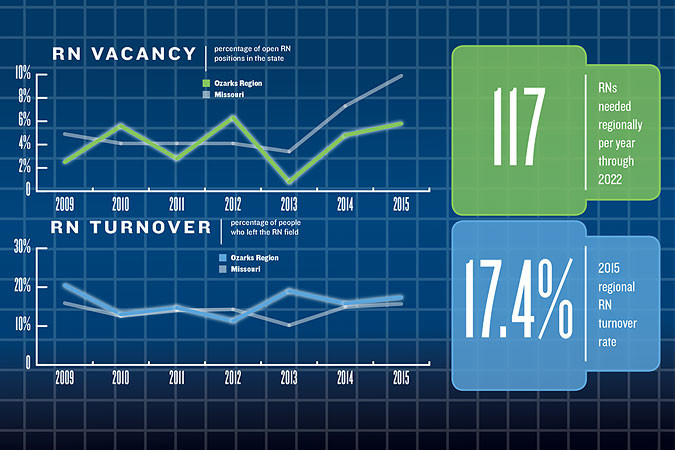YOUR BUSINESS AUTHORITY
Springfield, MO
YOUR BUSINESS AUTHORITY
Springfield, MO

Health care already is the No. 1 employer in southwest Missouri and the sector is poised for increased and rapid growth during the next decade.
The Missouri Hospital Association predicts the seven-county Ozark Workforce Investment Area will need an additional 117 registered nurses per year through 2022 just to keep pace with the need. But training and attracting new nurses aren’t the region’s only concerns – it also has a problem retaining them. At 17.4 percent, the RN turnover rate for the region surpasses the state average by nearly two percentage points.
“During the recession, people were more apt to hunker down, hold on to the job they had and ride out the storm,” said Kris Jones, corporate director of talent acquisition for CoxHealth. “When the unemployment rate is low and jobs are abundant, people feel more confident about leaving and taking a chance on another job.”
With roughly 200 nursing jobs currently open across the CoxHealth system, Jones said the MHA’s prediction of 117 RNs needed in coming years sounds low.
“We employ over 3,000 nurses right now, and that number is going to grow rapidly,” she said. “Growth plus attrition means most nursing positions will be in high demand.”
Why the shortage?
According to the MHA’s 2015 Workforce Report, many simultaneous factors are causing the rise in vacancy and turnover across the state. Jones cites baby boomers, the Affordable Care Act, medical advances and Missourians’ poor health.
“The baby boomers are a large generation who are starting to retire and that means a lot of nurses leaving the field,” she said. “It also means a lot of aging people who now need more medical care than ever, and that just compounds the problem.”
Among the RN workforce, 42 percent are age 50 or older, and it’s estimated nearly half of nurses over the age of 50 plan on retiring in 10 years.
Missouri’s entire population is aging at a rapid pace, with 14.2 percent age 65 or older, according to the MHA. By 2030, seniors are expected to make up nearly a quarter of Missouri’s population and chronic disease is driving up demand for services. About three-quarters of Missouri adults have at least one chronic disease, while more than half have at least two, according to the study. Combined, the issues place the Show-Me State in the bottom fourth of the nation’s unhealthiest states, according to the United Health Foundation.
Couple those factors with increased coverage under ACA, and the state is poised for a health care boom.
“Most of our nursing recruiting is focused on (licensed practical nurses) due to our extensive primary care clinic focus and a need for LPNs in those practice environments,” said Bernadette Losh, chief clinic officer for Ozarks Community Hospital, which operates two hospitals and 18 clinics throughout the Ozarks. “The current LPN shortage we believe is attributed in large part to bridge programs offered at nursing schools, where LPNs bridge to their RN. Many nurses are advancing from LPN to RN instead of joining the workforce after graduation.”
According to the MHA study, LPNs have a towering 27.8 percent turnover rate across the region, nearly double the state average of 15.5 percent.
CoxHealth’s Jones has similar concerns, siting a shortage of nursing instructors as the reason for small class sizes and a lag in nurse production.
Cox College President Lance Ratcliff believes that’s partly true.
“We have no problems finding faculty. In fact, we have numerous applications for each position we open,” he said of the CoxHealth-affiliated nursing school. “The bottleneck is on the clinical side, not in the classroom.
“A large part of a nurse’s training is practical clinical applications. Students shadow full-time nurses on the job. But getting a full-time nurse, who’s already intensely busy, is difficult.”
What can be done about it?
Ratcliff said the school is working with CoxHealth to address the clinician issue, making a concerted effort to work with the community to increase class sizes and expand recruitment. Ratcliff said the school graduated about 200 new nurses of varying degrees during the last academic year.
Throughout the seven-county region, which includes five reporting hospitals, the study found unlicensed assistive personnel were the greatest need, with a 12.7 percent vacancy rate, followed by occupational therapists, speech therapists, RNs and LPNs.
Jones believes recruitment will be key to staying on top of the need as CoxHealth works not just at the college level, but also on what she calls passive candidates.
“With the unemployment rate low, we need to capture the attention of people who aren’t seeking jobs,” she said. “These passive candidates already have jobs and aren’t looking. But if they notice something on social media that looks more appealing, they will go for it.”
To address its current need, OCH will host an LPN hiring fair later this month.
“We welcome both recent college graduates as well as seasoned nurses currently employed elsewhere,” she said. “We do find that we can train and mold new graduates to our culture. However, experience is a great benefit.”
Ratcliff believes the solution isn’t black and white.
“If you ask five people why there is a shortage, you will get five different answers and five different solutions,” he said. “Nursing faces some stiff competition.
“This is a significant problem that can only be solved through cooperation on every level throughout the health care community.”
Downtown problems partly a product of perception, officials say.
Updated: First Watch business partner sues another for breach of fiduciary duty, fraud
Physician sues CoxHealth, alleging business interference and defamation
Wendy’s franchisee ordered to pay $7M over harassment, PPP fraud accusations
Palm & Paddle Grille aims for mid-June launch
Report: UMB Financial Corp. in talks to make acquisition